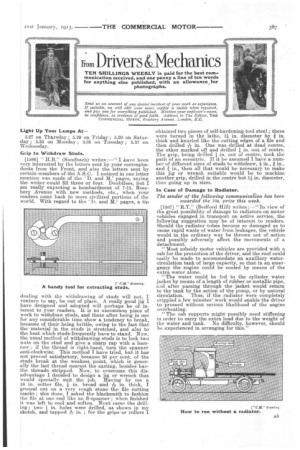TEN SHILLINGS WEEKLY is paid for the best communication received,
Page 17

If you've noticed an error in this article please click here to report it so we can fix it.
and one penny a line of ten words for anything else published, with an allowance, for photographs.
Send as an account of any special incident of your work or exPerience. If suitable, we will edit your notes, saq5Ply a sketch when required, and /ay you for everything published. Mention your employer's name, in confidence, as evidence of good faith. Address to The Editor, THE COMMERCIAL MOTOR, Rosebery. Avenue, London, E.G.
Light Up Your Lamps At
5.27 on Thursday; 5.29 on Friday ; 5.30 on Saturday; 5.33 on Monday ; 5.35 on Tuesday ; 5.37 on Wednesday.
Grip to Withdraw Studs.
[1586] " H.B." (Sandbach) writes :—" I have been very interested by the letters sent by your correspbndents from the Front, and also the letters sent by certain members of the A.S.C. I noticed in one letter mention was made of the, D. and M.' pages, saying the writer could fill three or four. Doubtless, but I am really expecting a bombardment of 7-15, Rosebery Avenue with new methods, etc., when your readers come back to more civilized portions of the
world. With regard to the and M.' pages, a tip . dealing with the withdrawing of studs will not, venture to say, be out of place. A really good jig I have designed and adopted will perhaps be of interest to your readers. It is no uncommon piece of work to withdraw studs, and these after being in use for any considerable time show a tendency to break, because of their being brittle, owing to the fact that the material in the studs is stretched, and also to the heat which. studs frequently have to stand. Now, the usual method of withdrawing studs is to lock two nuts on the stud and give a sharp rap with a hammer; if the thread is right-hand, turn the spanner anti-clockwise. This method I have tried, but it has not proved satisfactory, because 50 per cent, of the studs break at the weakest point, which is generally the last thread nearest the casting, besides haythe threads stripped. Now, to overcome this disadvantage I decided to design a, jig or wrench that would specially suit the job. Having by me a
16 in. cotter file, in. broad and N in. thick, I ground out on a very rough .stone the file cutting marks ; this done. I asked the blacksmith to fashion The file at one end like an S-spanner ; when finished it was left to cool and soften. Next came the drilling,; two in, holes were drilled, as shown in my sketch, and tapped TA; for the grips: or rollers I
obtained two pieces of self-hardening tool steel ; these were turned in the lathe, l in. diameter by in. thick and knurled like the cutting edges of a file and
then drilled in. One was drilled at dead centre, the other marked off and drilled / in. out of centre. The grip, being drilled I in. out of centre, took the path of an eccentric. If it be assumed I have a number of different sizes of studs to withdraw, in., and ;ai, in., then all that would be necessary to make this jig or wrench suitable would be to machine another grip, drilled in the centre but l in. diameter, thus going up in sizes.
In Case of Damage to Radiator.
The sender of the following communication has been awarded the 108. prize this week.
[1587] "RT." (Bedford Hill) writes : —" In view of the great possibility of damage to radiators on motor vehicles engaged in transport on active service, the following suggestion may be of interest to readers. Should the radiator tubes become so damaged as to cause rapid waste of water from leakages, the vehicle would in. the ordinary way be thrown out of action and possibly adversely affect the movements of a detachment.
" Most subsidy motor vehicles are provided with a cab for the protection of the driver, and the roof could easily be made to accommodate an auxiliary watercirculation tank of large capacity, so that in an emergency the engine could be cooled by means of the extra water alone.
" The water could be fed to the cylinder water jacket by means of a length of rubber or metallic pipe, and after passing through the jacket would return to the tank by the action of the pump, or by natural circulation. Thus, if the radiator were completely crippled a few minutes' work would enable the driver to proceed without serious likelihood of the engine overheating.
" The cab supports might possibly need stiffening in order to carry the extra load due to the weight of the water and tank. No difficulty, however, should be ,experienced in arranging for this."


















